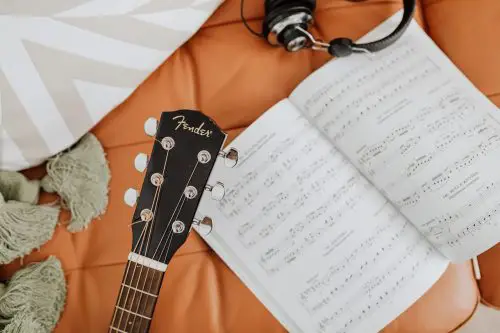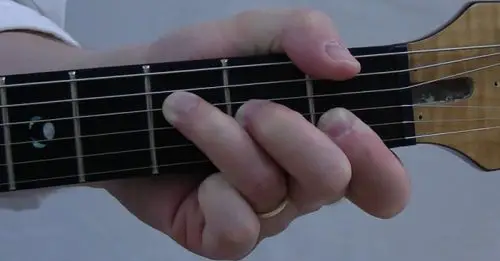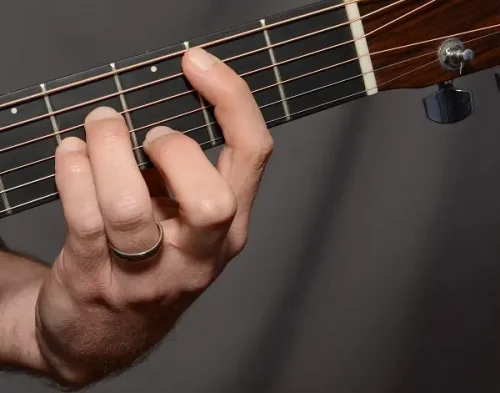Bending strings can be difficult for new guitar players (and even experienced guitar players) who have never tried it before. This is because bending strings is a motor skill. Just like any motor skill, it requires practice.
Learning the motor skill side of bending strings requires putting in the time and effort not only to know where and how to move your hand so that you can create the note but also to get to the point where you can just feel it. You can just do so instinctively without even thinking about it.
While bending strings is a motor skill, it is also an auditory skill. It may be challenging to create the sound you are looking for if you do not slow down at first so that you can ensure you are bending the notes to make just the notes you want. Increased speed can be developed later when playing with a metronome (more on that later).
Learning to bend strings properly requires practice to develop motor skills with your left hand (assuming this is the hand you would regularly use to press against the fretboard).
It also requires listening to ensure you are aware of the notes you are going for, so you can ensure you do not bend the strings too far or not far enough to create your desired sound.
If this sounds like a lot to process, I can assure you that it is not nearly as overwhelming as it may sound. As someone who has played guitar and bass for over 7 years, I can confirm that it can be tricky at first to learn how to bend your strings and do so while creating the best sound possible.
However, with consistent practice and dedication, the motor and listening skills to determine the right note will be picked up rather quickly.
In this article, we will go over nine tips to bend the strings correctly, with additional information regarding each tip to assist you with getting it down faster.
We will also go over several frequently asked questions, such as why it is so hard to bend my strings, how to stop hitting strings when they are being bent, why it is harder to do so on an acoustic, how to make the strings bend more effortless, and if thinner strings are easier to bend.
The following are the nine tips to help you create a better sound when bending your strings. Practicing these techniques will help you further progress with your practice sessions.
Please keep in mind that with learning any new motor skills, you actually have to take the time to do the activity physically.
While these tips below will not take the place of putting in the time and effort to practice, they will help to make you a better-sounding musician as long as you use them.
1. Bend lower frets

You will get a better sound out of your string bends if you slide your hand further down the neck
When bending strings, you will find it easier to do so with your hand in the correct position on the neck. Usually, going at least to the 7th fret will help make the actual bending of the string easier.
The closer your hand is to the guitar nut and tuning pegs, the more difficult it will be to bend the strings. You will also find that you will get a better sound out of your string bends if you slide your hand further down the neck toward the pickups and bridge.
2. Use Lighter gauge strings
A lighter gauge strings will help you bend your notes much more effortlessly. When you have a lighter gauge, you are playing strings that are wound less tightly and putting less tension on the bridge and neck of the guitar.
Additionally, you will stay in tune better with a lighter gauge string, even after bending them (strings of a heavier gauge will go sharp more quickly).
Also Read: Tightened Vs Loose Guitar Strings: Effects To Pitch & Tone
3. Know your target notes
When bending your strings, you should know exactly how much tension is required to create what notes you are creating when doing so.
I realize this may sound obvious; However, the bend will not help contribute to your playing if it is not in tune with what you want to do.
Bending from a C to a D is not going to sound good if you bend too far and go B to E flat, then back to a C if you are trying to make it go from C to C# to D.
4. Know your end note

The notes are determined by what fret you’re holding when you pick the string
Bending notes should be made while keeping the tonality of each note you are trying to hit in mind simultaneously.
I know this may sound silly again, but you are bending the strings not just to bend them and look cool but to create a specific sound you are going for.
For example, if you are on a B and bending to C, you should be aware that you will probably need to bend with less tension so that you do not go from B to C#, passing the C note.
Also Read: Ghost Note Vs Dead Note: Differences, Causes & How To
5. Keep your rhythm and keep it with the metronome
Your string bending should be on point as far as the note and/or notes you’re bending through to produce the best tonality possible. Bending a string to get your desired notes to stay in the key of the song you are playing will not help if you lose the rhythm while you are playing.
Here is an example of a drill you can practice:
One two three four. On the one count, you pluck the note; on the two count, the string bends, on the third count, the string has stopped bending, and you have hit the desired note you were going for. On the fourth count, you are back to the original note you started at.
6. Hand In The Correct Position (with thumb)

keeping your thumb in the proper position will help you to get correct position to develop the best motor skills
Keep your thumb up to or close to the top of the guitar neck when bending strings. This should create a bit less tension in your hand.
Bending strings is a motor skill that is similar to grabbing an object. Keeping your hand in the proper position will help you get just the correct position to develop the appropriate motor skills.
7. Use your ring and middle fingers

The power of two fingers helps bend the strings more efficiently
When bending your strings, using your ring and middle finger is a good idea to get the best possible hand strength and sound.
The additional power of the two fingers helps bend the strings more efficiently, thus creating a better sound.
When developing a motor skill where you need to use your hands more often, it is expected that you may find your hand gets tired and feels overworked a bit quicker than usual.
Bending your strings with the ring and middle finger will greatly help stop that from happening as quickly and severely.
8. Keep other fingers loose (for potentially muting)
To stop this from happening, just take your pinkie finger or any other free fingers you may have available on your left hand and lay it over the other strings you do not want to hit when doing your string bending. This can take a little practice, but it will come to you in time.
Anytime that you are bending strings, there is a possibility that you may be hitting other strings on the guitar as well. Hitting extra strings and having additional notes ring out when you do so could easily ruin your guitar solo.
9. Know When To Push Up and When To Push Down
To ensure that we do not push strings off the guitar’s neck when bending them, we push the lighter strings up and pull the lower strings down.
The lightest three strings, G, B, and E, should be pushed up toward the ceiling as this is the farthest direction these three lightest strings need to go to be pushed off of the neck of the guitar.
The heaviest three strings, E, A, and D, should be pulled down toward the floor, as this is the farthest direction they have to be pulled before they can come off the fretboard.
It is a common mistake to accidentally push too hard when bending your strings. This can result in moving the strings off of the neck itself, which ruins the entire tone of the song.
The following will let you know when to push up or pull down when bending your notes, depending on which string you are playing on
- E (higher string)-push up
- B-push up
- G-push up
- D-pull down
- A-pull down
- E (lower string)-pull-down
FAQs
Q: Why Is It So Hard to Bend My Strings?
Bending strings can be challenging when you first learn to do so. Here are a few reasons why it may be hard to bend your strings:
1. String gauge is too heavy
The string gauge may be too heavy, meaning too thick. Thicker strings require a bit more tension to hold in place. If you are pressing against too much pressure, your bends will be a bit tougher to do.
Consider replacing your strings with a lighter gauge to play songs where you want to be bending your strings regularly. This will put less tension on your guitar’s neck. Thus less pressure you have to press against.
2. You aren’t using the correct fingers
You can bend your strings with any hand that you would like. However, if you are pressing with just your index finger or just your ring finger, you may find it a bit strenuous on that finger.
You should place the ring finger on the note you want to play. When you begin the bend, your ring finger stays on that note. The middle and index finger can provide the strength needed to initiate the bend.
3. You aren’t placing your hand in the right spot
The closer your hand is to the head of the guitar neck (with the nut and tuning pegs), the more difficult you will find the physical act of bending the strings.
Please refer to this section in the article for more information on where to place your hands to prevent this.
Q: How Do I Stop Hitting My Strings While Bending?
By muting, you can stop accidentally hitting your other unintended strings when doing string bends.
To do so, simply place an available finger from the hand you use to bend the strings very lightly. There should be no pressure on the strings from your muting finger.
Q: Why Is Bending Harder on Acoustic?
Bending guitar strings is more challenging to do on an acoustic guitar than on an electric guitar due to the gauge of the strings. Acoustic guitars typically use strings of a heavier gauge than electric guitars do.
The lighter the gauge, the less tension the strings place on the neck and the guitar’s bridge. The lighter the pressure, the easier it is to bend the strings.
Q: How Do I Make My Guitar Strings Bend Easier?
Please consider getting a lighter gauge of string to help your string bend a bit easier. You can also check where on the neck your left hand is (assuming this is the hand you form your chords with) and which fingers you use to bend the strings. Please see the tips under the Frequently Asked Question ‘Why Is It So Hard To Bend My Strings.’
Please also refer to the bullet points under this article’s ninth tip: Know when to push up or down when bending strings. Following these recommendations will help to prevent you from pushing the strings off the guitar’s neck entirely.
Additionally, please keep in mind that bending strings is a motor skill. Just as with any motor skill, it will require practice and time to improve. Please keep this in mind when working to make your guitar strings bend more easily.
Q: Are Thinner Strings Easier to Bend?
Thinner strings are easier to bend than thicker strings. The thinner the string, the less overall tension it creates on the neck and bridge of the guitar. The less pressure there is in the guitar strings, the easier they will be to bend.
Conclusion
We covered nine tips to bend the strings correctly, with additional information regarding each tip.
We also covered several frequently asked questions, such as why is it so hard to bend my strings, how to stop hitting strings when they are being bent, why it is harder to do so on an acoustic, how to make the strings bend more easily, and if thinner strings are easier to bend.
Please remember that bending strings is a motor skill and an auditory skill. Like any skill, bending strings takes a bit of time and practice, so please do not let learning to do so be intimidating or off-putting. You will have it down with some dedication and training in no time.





